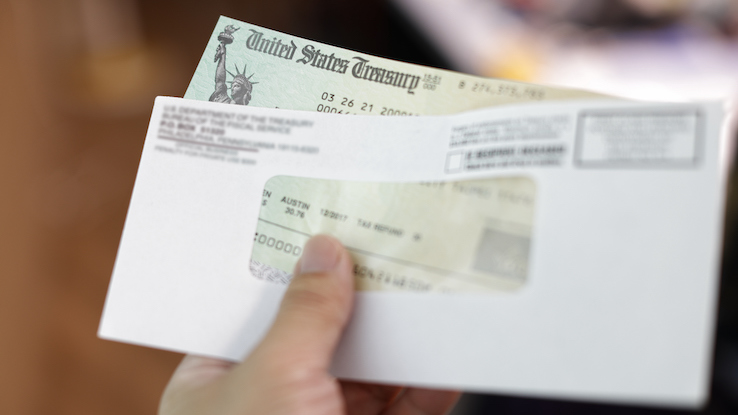
While finding extra money in your bank account is never a bad thing, it’s only natural to wonder how it got there. Sometimes, the funds may be from a mysterious sender that appears on your bank statement as “TREAS 310.”
While it might be a little disconcerting to see a seemingly random string of letters and numbers on your statement — and face the realization that some potentially unknown entity can access your account — there’s no need to worry. These payments aren’t from an anonymous benefactor, just the IRS. Read on to find out what TREAS 310 means and review several examples of times when you might spot the code on your bank statements.
Why Did I Get an IRS TREAS 310?
TREAS 310 payments indicate that you’ve received a government payment, typically from the IRS. The “TREAS” part of the code stands for “Treasury” because the IRS is a bureau of the United States Department of the Treasury.
The IRS commonly issues TREAS 310 payments for tax refunds, tax adjustments and government stimulus payments. In some cases, it can also indicate a refund if you overpaid on student loans or chose to receive a refund for payments you made during the timeframe specified in the CARES Act.
While the sender will typically appear as “IRS TREAS 310,” the statement may also include other bits of code that clarify the reason for the payment. Common additions include:
- “TAX REF” — As you may have guessed from the telltale clues, this code indicates that the payment is either for your tax refund or is the result of a tax adjustment.
- “TAXEIP3” — This code was commonly used during the COVID-19 pandemic to accompany stimulus payments. The “EIP” at the end stands for “Economic Impact Payment.”
- “CHILDCTC” — This code was used for advance payments of the Child Tax Credit increase of the American Rescue Plan of 2021. These payments were made between July and December 2021.

The Benefits of TREAS 310 Payments
The 310 at the end of TREAS 310 indicates a credit that’s been issued electronically via direct deposit. When it comes to distributing government-issued payments of any sort, direct deposit is an easier and more cost-effective option than mailing out millions of physical checks.
It can also help reduce the time it takes to receive your funds. When you file your taxes, you can usually expect a federal tax refund within three weeks if you opt to receive it via direct deposit.
In some instances, getting your refund may take a bit longer, especially if your return has any errors. Also, keep in mind that it may sometimes take your bank a few more days to move the funds into your account. In general, however, your TREAS 310 deposit should post to your account within about a month.
If you choose the snail mail route, however, it could take anywhere from six to eight weeks to get your physical check in the mail. If you want to track the progress of your return, you can always head over to the IRS website and check its status with the Where’s My Refund tool.
What Does TREAS 449 Mean?
If you ever get a tax refund that’s for a smaller amount than you were expecting, it may be accompanied by the code “TREAS 449″ instead of TREAS 310.
This indicates that you’ve received a reduced payment because the IRS has deducted some of the money from your refund to pay off delinquent debts. This is legal due to the Treasury Offset Program, which was designed to help collect overdue state and federal debts for things like child support payments.
If you find yourself in this situation, you should receive a notice clarifying exactly how much money was deducted from your return and the agency that the funds were paid to. It will also include the agency’s contact information so you can reach out if you have any questions or believe the funds were subtracted in error.

What Does SBAD TREAS 310 Mean?
It can initially be a bit alarming to notice that your bank statement features a payment marked “SBAD TREAS 310.” After all, the word “bad” is one you generally don’t want to see attached to any government-related banking transaction.
In this case, however, there’s nothing to worry about. This is simply the case of an unfortunate acronym used to indicate a Small Business Administration disaster payment. These payments became particularly common during the COVID-19 pandemic when many businesses were eligible for economic injury disaster loans, or EIDL.
Many businesses received two SBAD TREAS 310 payments, the first of which was smaller than the second. This was because the government sent out smaller EIDL advance payments first, and these were actually free advances that didn’t have to be paid back. The larger EIDL loan payments came later and did have to be paid back with interest.
Other Types of Federal Payments
Gone are the days when you had to wait for the postal service to deliver a benefit check from the government. As of March 1, 2013, the government and all government beneficiaries are now required to receive payments electronically.
Payments can now be made through direct deposit to either your regular bank account or a government-provided reloadable debit card. Federal payments are available via direct deposit for benefits like Social Security, Supplemental Security Income, and benefits from the VA and Department of Labor.
The government also offers countless grants and funding programs to individuals and businesses. This can also make it challenging to stay on top of all the individual codes that may appear alongside these transactions on your bank statement.
While the government technically offers online access to various agencies’ codes, it doesn’t exactly make for light reading. Rather than attempt to master the government’s accounting lingo, you’re better off researching any questionable codes you spot on your bank statement when it arrives. If you can’t find any information about the code online, don’t hesitate to contact your financial institution or accountant for help.





